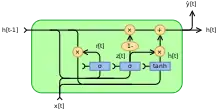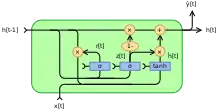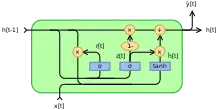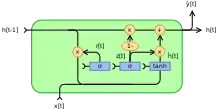Gated recurrent unit
Gated recurrent units (GRUs) are a gating mechanism in recurrent neural networks, introduced in 2014 by Kyunghyun Cho et al.[1] The GRU is like a long short-term memory (LSTM) with a forget gate,[2] but has fewer parameters than LSTM, as it lacks an output gate.[3] GRU's performance on certain tasks of polyphonic music modeling, speech signal modeling and natural language processing was found to be similar to that of LSTM.[4][5] GRUs have been shown to exhibit better performance on certain smaller and less frequent datasets.[6][7]
Architecture
There are several variations on the full gated unit, with gating done using the previous hidden state and the bias in various combinations, and a simplified form called minimal gated unit.[8]
The operator denotes the Hadamard product in the following.
Fully gated unit

Initially, for , the output vector is .
Variables
- : input vector
- : output vector
- : candidate activation vector
- : update gate vector
- : reset gate vector
- , and : parameter matrices and vector
- : The original is a sigmoid function.
- : The original is a hyperbolic tangent.
Alternative activation functions are possible, provided that .



Alternate forms can be created by changing and [9]
- Type 1, each gate depends only on the previous hidden state and the bias.
- Type 2, each gate depends only on the previous hidden state.
- Type 3, each gate is computed using only the bias.
Minimal gated unit
The minimal gated unit is similar to the fully gated unit, except the update and reset gate vector is merged into a forget gate. This also implies that the equation for the output vector must be changed:[10]
Variables
- : input vector
- : output vector
- : candidate activation vector
- : forget vector
- , and : parameter matrices and vector
References
- Cho, Kyunghyun; van Merrienboer, Bart; Gulcehre, Caglar; Bahdanau, Dzmitry; Bougares, Fethi; Schwenk, Holger; Bengio, Yoshua (2014). "Learning Phrase Representations using RNN Encoder-Decoder for Statistical Machine Translation". arXiv:1406.1078. Cite journal requires
|journal=(help) - Felix Gers; Jürgen Schmidhuber; Fred Cummins (1999). "Learning to Forget: Continual Prediction with LSTM". Proc. ICANN'99, IEE, London. 1999: 850–855. doi:10.1049/cp:19991218. ISBN 0-85296-721-7.
- "Recurrent Neural Network Tutorial, Part 4 – Implementing a GRU/LSTM RNN with Python and Theano – WildML". Wildml.com. 2015-10-27. Retrieved May 18, 2016.
- Ravanelli, Mirco; Brakel, Philemon; Omologo, Maurizio; Bengio, Yoshua (2018). "Light Gated Recurrent Units for Speech Recognition". IEEE Transactions on Emerging Topics in Computational Intelligence. 2 (2): 92–102. arXiv:1803.10225. doi:10.1109/TETCI.2017.2762739. S2CID 4402991.
- Su, Yuahang; Kuo, Jay (2019). "On Extended Long Short-term Memory and Dependent Bidirectional Recurrent Neural Network". arXiv:1803.01686.
- Su, Yuanhang; Kuo, Jay (2014). "Empirical Evaluation of Gated Recurrent Neural Networks on Sequence Modeling". arXiv:1412.3555 [cs.NE].
- Gruber, N.; Jockisch, A. (2020), "Are GRU cells more specific and LSTM cells more sensitive in motive classification of text?", Frontiers in Artificial Intelligence, 3, doi:10.3389/frai.2020.00040, S2CID 220252321
- Chung, Junyoung; Gulcehre, Caglar; Cho, KyungHyun; Bengio, Yoshua (2014). "Empirical Evaluation of Gated Recurrent Neural Networks on Sequence Modeling". arXiv:1412.3555 [cs.NE].
- Dey, Rahul; Salem, Fathi M. (2017-01-20). "Gate-Variants of Gated Recurrent Unit (GRU) Neural Networks". arXiv:1701.05923 [cs.NE].
- Heck, Joel; Salem, Fathi M. (2017-01-12). "Simplified Minimal Gated Unit Variations for Recurrent Neural Networks". arXiv:1701.03452 [cs.NE].